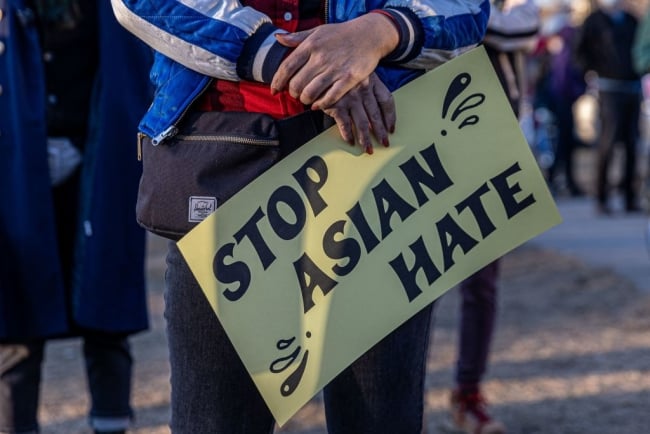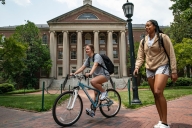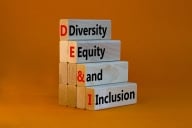You have /5 articles left.
Sign up for a free account or log in.

Asian Solidarity March after Atlanta shooting rampage that left six Asian Americans and two others dead.
Kerem Yucel/AFP/Getty Images
For Asian Americans especially, the Atlanta attack of last week marks a turning point as indelibly as the pandemic itself: from now on, there is before and there will be after. A white male has already confessed to the serial murder, six of the eight victims being Asian women.
While a police spokesman shockingly described the homicides as the perpetrator having had “a bad day” and subsequently was revealed himself to have spread the “China virus” meme on social media, people of all identities have come together. Discrimination against Asian Americans dates back to before Asians could become Americans. Awareness of it among others is as newfound as it is welcome.
Since the pandemic started, Asian Americans have been condemned collectively through guilt by association despite, as President Joe Biden pointed out before the massacre, being overrepresented as heroic health-care providers exposed on the front lines. Due to childish slogans aggrandized as conspiracy theories, we have been deemed to be the source of the scourge -- whether we are Chinese or not and even if we are third-generation Americans -- based on the color of our skin, the texture of our hair and the shape of our eyes. Some people have shunned or shied away from us on the street, implicitly fearing the disease. Others have even spat on some Asian Americans or shoved them to the ground with sufficient force to break bones, explicitly blaming them for the virus. The hostility is unmistakable, the cases underreported.
As a kid from Detroit, the cumulative effect of anti-Asian attitudes saddens me. I am not about to abandon my homeland (the United States, it should not be necessary to add). What troubles me most as an Asian American is that Asians abroad, many Asian exchange students and even some Asian immigrants recently arrived are doubting their choice: for them, the allure of America is vanishing. That is a devastating reversal for us -- for all Americans. The ideals that once beckoned the world over, inspiring sacrifice that likely will not be appreciated by the next generation thereby provided opportunities on these shores, no longer compel but instead feel empty. That accounts for Chinese officials displaying their attitude that the America century has come to it close at the Alaska summit just concluded.
Until recently, however, nobody except Asian Americans noticed rampant scapegoating, much less protested it. As the victim of a box-cutter face slashing lamented, “Nobody came, nobody helped.” The hypocrisy has not been lost on Asian Americans. A few have rejected the civil rights movement outright. They have been recruited through fake news on social media invisible to observers without language skills to fight affirmative action and critical race theory or to embrace the Asian nationalism of which they are suspected.
Race has always been difficult to discuss, whoever is implicated. But Asian Americans do not register as relevant at all. The black-and-white paradigm has been the problem all along. Yet the example of Asian Americans is useful exactly because of our being neither literally nor figuratively black and white.
Absent From the National Narrative
The great public intellectual W. E. B. Du Bois, a “race man” among the founders of the National Association for the Advancement of Colored People, championed Black equality within the context of universal norms. His most famous line, penned in 1903 for the canonical essays collected as Souls of Black Folk, is typically misquoted. He is remembered for predicting that “the problem of the 20th century is the problem of the color line.” Students who repeat that phrase in a paper might not have read the passage in full, for he continued, with a comma, “the relations of the darker to the lighter races of men in Asia and Africa, the Americas and the islands of the sea.”
Again and again, the most persuasive activists have enlisted allies. Asian Americans participated in the civil rights movement back in the day. The Japanese American Citizens League, established in 1929, sent a delegation to march alongside Martin Luther King Jr. in Washington, D.C., in 1963. King not only said, “I have a dream,” but also, “We cannot walk alone.” Yuri Kochiyama cradled the head of the dying Malcolm X in the Audubon Ballroom two years later.
Framing race as if everyone fits neatly into either a black box or a white box produces a picture of the world that fails to correspond to reality. Out of fidelity to fact and care for accurate analysis, not ideology or acquiescence to the ascent of overseas regimes, Asian Americans ought to be included. A stroll across any college campus or glance at a Zoom class would reveal the abundance of Asian exchange students, Asian immigrants and Asian Americans -- whether South, East, Southeast or Pacific in origin; Christian, Buddhist, Muslim or Hindu; Afro-Asian or adopted by white parents; privileged or food insecure. Regardless of academic discipline or policy recommendations, any serious study of racial dynamics that omits 20 million Asian Americans -- or for that matter, Latinos and all who have been conventionally relegated to the status of “others” at the end of lists -- cannot explain what is happening for the deliberate lack of crucial data.
Asian Americans have been around since the United States Civil War but are absent from the national narrative. Hundreds fought in both the Union as well as Confederate armies, a history that is integral but not integrated. Chinese laborers built the western half of the transcontinental railroad, risking life and limb, as in the phrase of the era, “a Chinaman’s chance,” denoting low odds of surviving. None of their faces appear in the iconic photographs of the Golden Spike ceremony at Promontory Point, Utah, in 1869.
Then Asian Americans were driven out of western territories, as white mobs torched Chinese villages and lynched their fleeing residents. The rallying cry of “the Chinese must go!” led to the Exclusion Act of 1882, expanded to an Asiatic Barred Zone in 1917. Asian newcomers and their few American-born progeny fought back against open bigotry, which spanned from reactionary government officials who invoked the fear of “miscegenation” to progressive labor leaders who claimed unfair competition owing to whites needing a diet of meat while Asiatics could subsist on rice. Wong Kim Ark of San Francisco, stopped at the border, hired the best Caucasian lawyers, besting the U.S. Justice Department, which argued that if citizenship were available to persons of Chinese descent, it would no longer be worth possessing. He secured the guarantee of birthright citizenship for all, as promised by the 14th Amendment to the Constitution.
The literal mistake leads to its figurative counterpart of allowing only interpretations that are absolute and without ambiguity. Almost everyone prefers, as Hannah Arendt explicated, wrongdoing to be egregious and intrinsic to a transgressor’s character. We anticipate apprehending an offender who is malign and wicked, and obviously so. Against such a villain we yearn to juxtapose a victim who is contrastingly innocent and pure. A story that is complicated, involving mixed motives and sexualization, becomes confusing and uncomfortable. Thus, we are distracted by the debate over whether the Atlanta shooter was a bigot through and through, as if his self-serving declaration that he is free of intolerance absolves him and by implication the rest of us, too. Or we propose that racism erases sexism, and vice versa, disrespecting Asian women as much as a fetish for them is the opposite of the love it purports to be.
Racial in Effect
Asian Americans show another possibility. An act can be free of racism in intent but nonetheless be fraught because it is racial in effect. The asymmetry should be apparent. The suffering is disproportionately inflicted. The common cruelty of childhood, the relentless bullying that Asian American kids experience, is racialized. The name-calling humiliates a child into hating her ancestors. As much as it might be protected as free speech, the “ching chong” singsong and eyes pulled back into slants inspire the sticks and stones and portend worse.
A sophomoric version persists into college with the theme of Asians “taking over,” with the irony that those who have offended arguing that they in turn have become ostracized. The University of California, Los Angeles, student who went viral with a video about “hordes of Asian people” who refused to follow American manners, and then uttered gibberish as mock Asian speech, dropped out following what she called “harassment.”
Slurs, obscenities and challenges to kung fu contests are all funny enough and trivial indeed to those who administer them without remorse. To the butt of the joke who is subjected to a daily ordeal, it holds no humor but only trauma for life. The Chinese phrase for the anguish is “to eat bitterness.”
Meanwhile, the ongoing “China Initiative” suggests even a number of professors of Chinese ancestry who have achieved distinction are sleeper agents of an enemy power. According to all the ongoing investigations, they belong en masse to a conspiracy of espionage or theft of trade secrets, to be rooted out. The prosecution has turned into persecution, as partnerships promoted by universities and funders alike less than a decade ago pass into disapproval and criminality.
Perhaps Asian Americans, at least those in the predicament of “doing science while Chinese,” will come to sympathize with African Americans, who are aggrieved to be arrested for “driving while black.” The excuses of racial profiling are less denials of the prejudice than assertions about the superficial plausibility of generalizations. Accusers rationalize their strategy by noting someone else of the same heritage has already pleaded guilty, and it would be common sense anyway to recruit operatives by appealing to ethnic affinity.
The narratives about the pandemic and espionage blend together in the thesis that a cataclysmic “clash of civilizations” is imminent. The “Thucydides Trap” has been set, a scenario pitting the rising power, China, versus the declining power, America. Eschatological conflict will escalate from cultural rivalry and trade disputes to actual military maneuvers.
Asian Americans who identify by the term are joining a coalition with those whom their forebears fought total wars for the sake of civic engagement here. However clichéd, the heckler’s jeer awaits.
The perpetual foreigner syndrome recurs as the demanding question “where are you really from,” with a tone incredulous of your sincere answer to “where are you from,” and the dubious compliment, “My, you speak English so well.” The insinuation is an Asian American belongs in Asia, speaking with an accent. An Asian American who insists they are who they say they are seems preposterous, trying too hard to fit in and in the process confirming the futility of assimilation. The subtle bias comes out in the assumption that all Asians are sojourners and well-to-do, or in that pejorative phrase finally reappropriated by a hit sitcom, Fresh Off the Boat. The Asian American from California or New York City, who has never visited Asia, is not immune to the racism that expresses itself toward her grandparents in the form of xenophobia.
I continue to believe in the American dream. That is why I yearn for us to live up to our principles as a diverse democracy. Institutions of higher education will always have an important role to play as civic institutions where people who might not encounter one another elsewhere live together and work together as equals. The numbers of Asian Americans at most colleges and universities offer an opportunity not available in other contexts. May the Atlanta tragedy lead to American progress. Our shared future is at stake.








